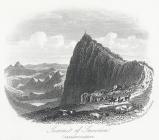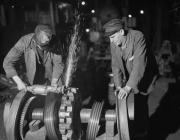Snowdon Mountain Railway
Items in this story:
Initial discussions
The railway was opened from Caernarfon to Llanberis in 1869. Before the railway was built people either walked or rode a donkey to reach the summit. George William Duff Assherton Smith, a local landowner opposed the plans. He believed that the railway would be a blot on the landscape and he refused his permission for the railway to cross his land.
Twenty years later, it was decided that the railway could begin its journey from Rhyd Ddu which is located on the other side of the mountain. This decision caused concern amongst the residents of Llanberis. They were worried that the village would lose trade from prospective tourists. In response to growing pressure Assherton Smith gave his permission to build the railway on its land.
On November 16, 1894 "Snowdon Mountain Tramroad and Hotels Co. Ltd. "(Snowdonia Mountain Railway Co.) was formed and tasked to build the railway to the summit.
Challenges in building
The first challenge was to find the safest method to transport the trains up the steep slopes. The Snowdon Mountain Tramroad and Hotels Co. Ltd. visited Switzerland to find the most advanced mountain railway technology. The company came across Dr Roman Abt, a German engineer's rack and pinion system. His system had been trialled in the Alps. In 1895, while in Switzerland the company purchased three steam locomotives to assist in the construction of the railway and a further two locomotives arrived in 1896 when the railway was opened. The locomotives pushed the carriages up the mountain. Each carriage had a set of brakes and they operated independently of the locomotives. If the driver were to lose control, the carriage would come to a halt, detaching itself from the locomotive.
The double rail track ensured a smooth and comfortable journey up the steep slopes. The pinion was mounted underneath the train, ensuring that there was a sound grip between both carriage and track. The pinion was the only form of grip between both, with the wheels supporting the weight of the locomotive.
The first turf was cut at Llanberis station in December 1894 by Enid, the daughter of Assherton Smith. The intention was to open the line in the summer of 1895, but due to the harsh winter of 1894 the construction of the two large aqueducts between Llanberis and the waterfall weren't completed until August 1895. The track to the summit was laid in 72 days, with the first train reaching the summit in January 1896. After the completion of the fencing and installation of the signalling system the railway was opened to the public during Easter 1896.
Officially opened
The railway was opened to the public on Easter Monday 6 April 1896. LADAS, train number 1 was the first to climb the slopes with two carriages full of passengers. The train was named after Laura Alice Duff Assheton-Smith, wife of the landowner whom gave the land for construction of the railway. LADAS was followed by Enid, train number 2. Name after the daughter of George William Duff Assheton-Smith. There weren't any difficulties in reaching the summit even though it was a misty day. Shortly after noon, LADAS began to descend down the mountain. Apparently the train driver, William Pickles, experienced difficulty in keeping the train under control. About half a mile above the cliff, the train derailed, although initially the locomotive continued to follow the track, eventually the driver lost control. The driver and stoker jumped out of the locomotive. The LADAS locomotive travelled uncontrollably for nearly 100 metres before coming to a corner, then came loose from the track and tipped over the side of the mountain.
The carriages' automatic brake system fortunately worked and brought the carriages to a standstill. Unfortunately Ellis Griffith Roberts of Llanberis jumped out of one of the carriages in a panic. As he landed he knocked his head on the ground and died of his injuries. As LADAS derailed, it broke the telegraph lines, which was the communication line between the stations. The second train, Enid, received a signal to say that the track was clear for it to begin its descent. The same tragedy happened to this train, but in this instance, the locomotive crashed into LADAS' carriages and derailed.
Following the disaster a maximum load was implemented on the carriages and the line was closed for a year while a gripper rail was installed on the track. The railway was reopened a year to the day, Easter Monday, 1897. There were no other issues with the line after that incident.
Snowdon Summit
The first shelter was built on the summit in 1820, selling refreshments and providing shelter for walkers. By 1847, there were several log cabins and two hotels on the summit. "The Roberts Hotel" which was run by John Roberts and the second "Cold Club" which was run by William Roberts (no relation). There was fierce competition between the two businesses. Apparently, both hotels were in poor condition and more often than not there were more visitors than beds.
Following legal negotiations in 1896, the “Snowdon Mountain Tramroad and Hotels" company took over the responsibility for the two hotels, and by 1898, work began on rebuilding of the hotel and adding a veranda. A small hut was also built for railway staff at the site of the existing cafe, but was not there long. A small station was opened in its place. The buildings were greatly affected by the inclement weather, and by 1930 all the buildings were in terrible condition. It was resolved that a multi-purpose building would be build in their place, to include a hotel, cafe and a train station. The old buildings were demolished over the hillside to make room for the new buildings.
The new building was designed by Sir Clough Williams-Ellis, the architect who designed Portmeirion, and the building was completed in 1935. The most prominent features were huge windows on the front and side of the building for visitors to enjoy the scenery. Unfortunately, the windows shattered in a storm six months later, and smaller windows were installed in their place. The cafe was closed during the Second World War and was used by the Ministry of Supply for experimental radio work, and later by the Air Force to develop radar. The Admiralty carried out intelligence work there for a while and finally it was occupied by the Army. Despite the improvements that were made in the 1950s and 1960s, the cafe deteriorated.
In 2004 it was decided to rebuild the cafe and build a new visitors' centre. Clough Williams-Ellis' structure was demolished in 2006 and once again the weather was a hindrance. On most days the builders had to walk from Cliff station. Pupils from Beddgelert and Dolbadarn buried a time capsule near the new building. The capsule will be reopened in 2058.
Hafod Eryri was opened to the public on the 12th of June 2009.



